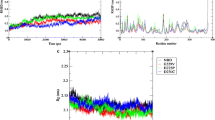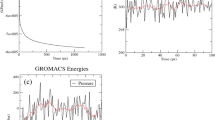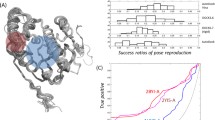Abstract
The aim of investigating protein interaction between Homo sapiens adenovirus and heat shock 70 kDa protein (Hsp70) is to study a potentially synergistic interaction that would enhance the anti-apoptotic mechanisms, hence increasing the virus replication rate and improve the killing efficiency of tumour cells in cancer therapy. Currently, the protein interaction between Hsp70 and E1A 32 kDa of human adenovirus C serotype 5 (Ad5) is still unknown. Mutant models (T11V, T12P and D364S) were built, simulated and their interactions with Ad5 were studied. The E1A 32 kDa of human Ad5 motif (PNLVP) showed the lowest binding energy and intermolecular energy values with the novel T11V mutant at −8.26 kcal/mol and −11.21 kcal/mol. The protein-ligand complex models revealed that the T11V mutant had the strongest and most stable interaction with the PNLVP motif among all the four protein-ligand complex structures. This knowledge would assist future in vivo investigations of this protein-ligand complex structure in cancer treatment research.
Similar content being viewed by others
Abbreviations
- Ad5:
-
adenovirus C serotype 5
- GRAVY:
-
grand average of hydropathicity
- HLS:
-
helical lid subdomain
- Hsp:
-
heat shock protein
- Hsp70:
-
heat shock 70 kDa protein
- MD:
-
molecular dynamics
- NBD:
-
nucleotide-binding domain
- RMSD:
-
root mean square deviation
- RMSF:
-
root mean square fluctuation
- SASA:
-
solvent accessible surface area
- SBD:
-
substrate-binding domain
- SBSD:
-
substrate-binding subdomain
References
Abavaya K., Morimoto R.I., Murphy S.P. & Myers M.P. 1992. The human heat shock protein Hsp70 interacts with HSF, the transcription factor that regulates heat shock gene expression. Genes Dev. 6: 1153–1164.
Adusumilli P.S., Carpenter S.G., Chan M.K., Eisenberg D.P., Fong Y., Hendershott K.J. & Yu Z. 2010. Hyperthermia potentiates oncolytic herpes viral killing of pancreatic cancer through a heat shock protein pathway. Surgery 148: 325–334.
Ansieau S. & Leutz A. 2002. The conserved Mynd domain of BS69 binds cellular and oncoviral proteins through a common PXLXP motif. J. Biol. Chem. 277: 4906–4910.
Aprile F.A., Dhulesia A., Stengel F., Roodveldt C., Benesch J.L.P., Tortora P., Robinson C.V., Salvatella X., Dobson C.M. & Cremades N. 2013. Hsp70 oligomerization is mediated by an interaction between the interdomain linker and the substrate-binding domain. PLoS One 8: 1–17.
Aparoy P., Kuntal B.K. & Reddanna P. 2010. EasyModeller: a graphical interface to MODELLER. BMC Res. Notes 3: 226.
Benyo B., Benyo Z., Biro J.C., Fordos G., Micsik T., Sansom C. & Szlavecz A. 2003. A common periodic table of codons and amino acids. Biochem. Biophys. Res. Commun. 306: 408–415.
Berendsen H.J.C., Groenhof C., Hess B., Lindahl E., Mark A.E. & van Der Spoel D. 2005. GROMACS: fast, flexible, and free. J. Comput. Chem. 26: 1701–1718.
Bertelsena E.B., Chang L., Gestwickib J.E. & Zuiderwega E.R.P. 2009. Solution conformation of wild-type E. coli Hsp70 (DnaK) chaperone complexed with ADP and substrate. Proc. Natl. Acad. Sci. USA 106: 8471–8476.
Brandi M., Hilgenfeld R., Pal D., Sühnel J. & Weiss M.S. 2001. More hydrogen bonds for the (structural) biologist. Trends Biochem. Sci. 26: 521–523.
Bukau B. & Horwich A.L. 1998. The Hsp70 and Hsp60 chaperone machines. Cell 92: 351–366.
Bukau B., Mayer M.P. & Vogel M. 2006. Allosteric regulation of Hsp70 chaperones involves a conserved interdomain linker. J. Biol. Chem. 281: 38705–38711.
Burgoyne N.J. & Jackson R.M. 2006. Predicting protein interaction sites: binding hot-spots in protein-protein and proteinligand interfaces. Bioinformatics 22: 1335–1342.
Cabra Ledesma V.C., Kumar D.P., Sarbeng E.B., Vorvis C. & Willis J.E. 2011. The four hydrophobic residues on the Hsp70 inter-domain linker have two distinct roles. J. Mol. Biol. 411: 1099–1113.
Colovos C. & Yeates T.O. 1993. Verification of protein structures: patterns of non-bonded atomic interactions. Protein Sci. 2: 1511–1519.
Costantini S., Colonna G. & Facchiano A.M. 2008. ESBRI: a web server for evaluating salt bridges in proteins. Bioinformation 3: 137–138.
Craig E.A. & Stone D.E. 1990. Self-regulation of 70 kilodalton heat shock proteins in Saccharomyces cerevisiae. Mol. Cell. Biol. 10: 1622–1632.
Dinier G., Montgomery D.L., Sivendran R., Stotz M. & Swain J.F. 2007. Hsp70 chaperone ligands control domain association via an allosteric mechanism mediated by the interdomain linker. Mol. Cell 26: 27–39.
Eisenberg D., Luthy R. & Bowie J.U. 1997. VERIFY3D: assessment of protein models with three-dimensional profiles. Methods Enzymol. 277: 396–404.
Elengoe A., Hamdan S. & Naser M.A. 2014. Modeling and docking studies on novel mutants (K71L and T204V) of the AT-Pase domain of human heat shock 70 kDa protein 1. Int. J. Mol. Sci. 15: 6797–6814.
Fiser A. & Sali A. 2003. Modeller: generation and refinement of homology-based protein structure models. Methods Enzymol. 374: 461–491.
Freeman B.C., Joachimiak A., Morimoto R.I., Osipiuk J. & Sriram M. 2007. Human Hsp70 molecular chaperone binds two calcium ions within the ATPase domain. Structure 5: 403–414.
Freeman B.C. & Yamamoto K.R. 2002. Disassembly of transcriptional regulatory complexes by molecular chaperones. Science 296: 2232–2235.
Gasteiger E., Hoogland C., Gattiker A., Duvaud S., Wilkins M.R. & Appel R.D. 2005. Protein identification and analysis tools on the ExPASy server, pp: 571–607. In: Walker J.M. (ed.) The Proteomics Protocols Handbook. Humana Press.
George Priya Doss C. & Nagasundaram N. 2012. Investigating the structural impacts of I64T and P311S mutations in APE1-DNA complex: a molecular dynamics approach. PLoS One 7: 1–11.
Gething M.J. & Sambrook J. 1992. Protein folding in the cell. Nature 355: 33–45.
Gilis D. & Rooman M. 1997. Predicting protein stability changes upon mutation using database-derived potentials: solvent accessibility determines the importance of local versus non-local interactions along the sequence. J. Mol. Biol. 272: 276–290.
Glotzer J.B., Saltik M., Chiocca S., Michou A.L, Moseley P. & Cotton M. 2000. Activation of heat-shock response by an adenovirus is essential for virus replication. Nature 407: 207–211.
Golas E.I., Czaplewski C., Scheraga H.A. & Liwo A. 2015. Common functionally important motions of the nucleotidebinding domain of Hsp70. Proteins 83: 282–299.
Golas E., Maisuradze G.G., Senet P., Oldziej S., Czaplewski C., Scheraga H.A. & Liwo A.J. 2012. Simulation of the opening and closing of Hsp70 chaperones by coarse-grained molecular dynamics. J. Chem. Theory Comput. 8: 1750–1764.
Imperiale M.J, Kao H.T., Feldman L.T., Nevins J.R. & Strickland S. 1984. Common control of the heat shock gene and early adenovirus genes: evidence for a cellular ElA-like activity. Mol. Cell. Biol. 4: 867–874.
Hatebour C., Gennissen A., Ramos Y.F., Kerkhoven R.M., Sonntag-Buck V, Stunnenberg H.G. & Bernards R. 1995. BS69, a novel adenovirus ElA-associated protein that inhibits E1A transactivation. EMBO J. 14: 3159–3169.
Hendrickson W.A. & Liu Q. 2007. Insights into Hsp70 chaperone activity from a crystal structure of the yeast HspllO Ssel. Cell 131: 106–120.
Hightower L.E. 1991. Heat shock, stress proteins, chaperones, and proteotoxicity. Cell 66: 191–197.
Hurley J.H. 1996. The sugar kinase heat shock protein 70 actin super family: Implications of conserved structure for mechanism. Annu. Rev. Biophys. Biomol. Struct. 25: 137–162.
Jackson R.M. & Laurie A.T. 2005. Q-SiteFinder: an energy-based method for the prediction of protein-ligand binding sites. Bioinformatics 21: 1908–1916.
Johnson E.R. & McKay D.B. 1999. Mapping the role of active site residues for transducing an ATP-induced conformational change in the bovine 70-kDa heat shock cognate protein. Biochemistry 38: 10823–10830.
Kampinga H.H., Hageman J., Vos M.J., Kubota H., Tanguay R.M., Bruford E.A., Cheetham M.E., Chen B. & Hightower, L.E. 2009. Guidelines for the nomenclature of the human heat shock proteins. Cell Stress Chaperones 14: 105–111.
Kampinga H.H & Craig E.A. 2010. The Hsp70 chaperone machinery: J-proteins as drivers of functional specificity Nat. Rev. Mol. Cell Biol. 11: 579–592.
Kityk R., Kopp J., Sinning I. & Mayer M.P. 2012. Structure and dynamics of the ATP-bound open conformation of Hsp70 chaperones. Mol. Cell 48: 863–874.
Koellner G. & Steiner T. 2001. Hydrogen bonds with p-acceptors in proteins: frequencies and role in stabilising local 3-D structures. J. Mol. Biol. 305: 535–557.
Laufen T., Mayer M.P., Paal K., Rüdiger S. & Schröder H. 2000. Multistep mechanism of substrate binding determines chaperone activity of Hsp70. Nat. Struct. Biol. 7: 586–593.
Laskowski R.A., MacArthur M.W., Moss D.S. & Thornton J.M. 1993. PROCHECK: a program to check the stereochemical quality of protein structures. J. Appl. Cryst. 26: 283–291.
Masselink H. & Bernards R. 2000. The adenovirus E1A binding protein BS69 is a corepressor of transcription through recruitment of N-CoR. Oncogene 19: 1538–1546.
Mayer M.P., Brehmer D., Gassler C.S. & Bukau B. 2001. Hsp70 chaperone machines. Adv. Protein Chem. 59: 1–44.
Netzer W.J. & Hartl, F.U. 1998. Protein folding in the cytosol: chaperonin-dependent and -independent mechanisms. Trends Biochem. Sci. 23: 68–73.
Nicolai A., Senet P., Delarue P. & Ripoll D.R. 2010. Human inducible Hsp70: structures, dynamics, and interdomain communication from all-atom molecular dynamics simulations. J. Chem. Theory Comput. 206: 2501–2519.
O’Brien M.C., Flaherty K.M. & McKay D.B. 1996. Lysine 71 of the chaperone protein Hsc70 is essential for ATP hydrolysis. J. Biol. Chem. 271: 15874–15878.
Palleros D.R., Reid K.L., Shi L., Welch W.J. & Fink A.L. 1993. ATP-induced protein Hsp70 complex dissociation requires K+ but not ATP hydrolysis. Nature 365: 664–666.
Ritossa F. 1962. A new puffing pattern induced by heat shock and DNP in Drosophila. Experientia 18: 571–573.
Roy S., Maheshwari N., Chauhan R., Sen N.K. & Sharma A. 2011. Structure prediction and functional characterization of secondary metabolite proteins of Ocimum. Bioinformation 6: 315–319.
Rupley J.A. & Shrake A. 1997. Environment and exposure to solvent of protein atoms. Lysozyme and insulin. J. Mol. Biol. 79: 351–371.
Sanner M.F. 1999. Python: a programming language for software integration and development. J. Mol. Graph. Model. 17: 57–61.
Schuttelkopf A.W. & van Aalten D.M. 2004. PRODRG — a tool for high-throughput crystallography of protein-ligand complexes. Acta Crystallogr. D Biol. Crystallogr. 60: 1355–1363.
Simon M.C., Kitchener K., Kao H.T., Hickey E., Weber L., Voellmy R., Heintz N. & Nevins J.R. 1987. Selective induction of human heat shock gene transcription by the adenovirus E1A gene products, including the 12S E1A product. Mol. Cell. Biol. 7: 2884–2890.
Sousa M.C. & McKay D.B. 1998. The hydroxyl of threonine 13 of the bovine 70-kDa heat shock cognate protein is essential for transducing the ATP-induced conformational change. Biochemistry 37: 15392–15399.
Stone D.E. & Craig E.A. 1990. Self-regulation of 70 kilodalton heat shock proteins in Saccharomyces cerevisiae. Mol. Cell. Biol. 10: 1622–1632.
Vasconcelos D.Y., Cai X.H. & Oglesbee M.J. 1998. Constitutive overexpression of the major inducible 70 kDa heat shock protein mediates large plaque formation by measles virus. J. Gen. Virol. 79: 2239–2247.
Wallner B. & Elofsson A. 2003. Can correct protein models be identified? Protein Sci. 12: 1073–1086.
White E., Spector D. & Welch W. 1988. Differential distribution of the adenovirus E1A proteins and colocalization of E1A with the 70-kilodalton cellular heat shock protein in infected cells. J. Virol. 62: 4153–4166.
Wickner S., Skowyra D., Hoskins J. & Mckenney K. 1992. DnaJ, DNAK, and GrpE heat shock proteins are required in oriPl DNA replication solely at the RepA monomerization step. Proc. Natl. Acad. Sci. USA 89: 10345–10349.
Wiederstein M. & Sippl M. 2007. ProSA-web: interactive web service for the recognition of errors in three-dimensional structures of proteins. Nucleic Acids Res. 35: W407-W410.
Yamamoto M. & Curiel, D.T. 2010. Current issues and future directions of oncolytic adenoviruses. Mol. Ther. 18: 243–250.
Zhuravleva A. & Gierasch M. 2010. Allosteric signal transmission in the nucleotide-binding domain of 70kDa heat shock protein (Hsp70) molecular chaperones. Proc. Natl. Acad. Sci. USA 108: 6987–6992.
Zuiderwerg E.R.P., Bhattacharya A., Kurochkin A.V., Yip G.N.B., Zhang Y. & Bertelsen E.B. 2009. Allostery in Hsp70 chaperones is transduced by subdomain rotations. J. Mol. Biol. 388: 475–490.
Author information
Authors and Affiliations
Corresponding author
Rights and permissions
About this article
Cite this article
Elengoe, A., Naser, M.A. & Hamdan, S. Molecular dynamics simulation and docking studies on novel mutants (T11V, T12P and D364S) of the nucleotide-binding domain of human heat shock 70 kDa protein. Biologia 70, 1655–1671 (2015). https://doi.org/10.1515/biolog-2015-0194
Received:
Accepted:
Published:
Issue Date:
DOI: https://doi.org/10.1515/biolog-2015-0194




